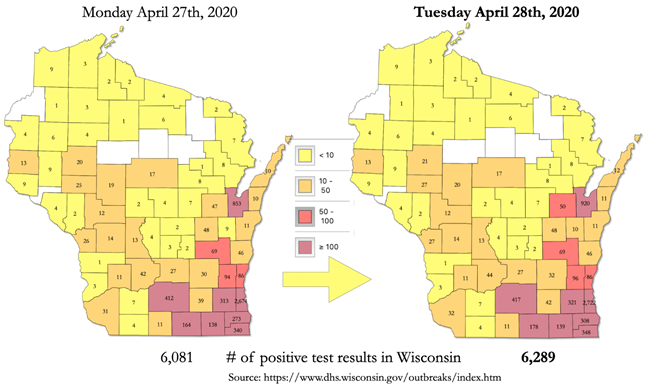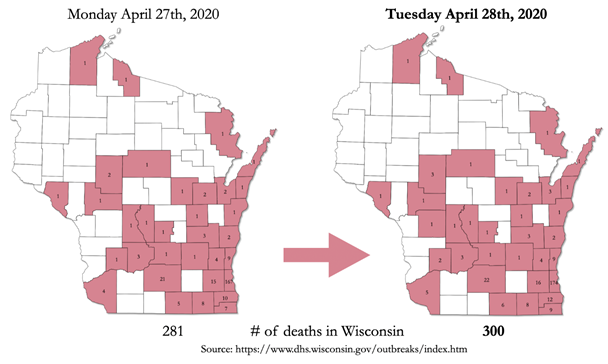Georgia
As of April 29th
- Daily State Public Health stats:
- As of 1:25 p.m. Wednesday, State cases are up to 25,572 confirmed cases as compared to 25,274 Wednesday noon, with 5,056 hospitalized patients as compared to 4,948 Wednesday noon, and 1,093 deaths as compared to 1,052 Wednesday noon.
- Some models show Georgia’s death rate could nearby double by August.
- Yesterday, nearly 13,000 new tests were reported to GDPH. Free testing is available by calling 706-721-1852.
- Andy Miller of GA Health News reports that 40 percent of GA nurses don’t feel safe or equipped to perform their duties during the pandemic.
- The Club for Growth has endorsed Tiger state representative Matt Gurtler for the 9th District seat currently held by Doug Collins.
- Per UGA president Jere Morehead, he expects to hold classes in August with Maymester and Summer online.
- Bubba McDonald has endorsed Doug Collins in his bid for Senate.
Virginia
As of April 29th
The latest in Virginia, as of Wednesday, April 29:
Total cases: 14,961
Hospitalizations: 2,259
Deaths: 522
The latest:
- Outpatient, elective and non-emergency medical and dental procedures, and the full array of veterinary procedures and services, will be allowed, effective Friday, May 1.
- The governor credited the stay-at-home order and the commonwealth’s overall response for successfully preventing a surge of COVID-19 cases that could have overwhelmed hospitals and available resources.
- The outlook for personal protective equipment and hospital beds is stabilizing, the governor said.
Gov. Ralph Northam offered cautious optimism in a press conference Wednesday, where he announced he would allow elective and non-emergency medical and dental procedures to resume on Friday, May 1. He also announced veterinarians would be allowed to resume offering their “full array” of services and procedures on that date, too, while maintaining efforts to minimize the potential spread of infection.
Northam credited the response to the pandemic – increased teleworking, business closures, social distancing, among other efforts – for protecting Virginia from a worst-case scenario that many feared one month ago. He praised hospitals and healthcare systems for making sacrifices to preserve supplies of personal protective equipment for the workers dealing directly with patients who had COVID-19. Replenished supplies of protective gear and increasing stabilization of hospital resources directed at COVID-19 treatment led to the decision to allow elective procedures to resume, the governor said.
The decision is a first step in helping to staunch the massive economic losses that have devastated state and local economies; the healthcare industry, in particular, has been among the hardest hit by the response to the pandemic, with waves of layoffs, furloughs and pay cuts. Elective and non-emergency medical procedures were temporarily banned by the governor in mid-March.
A phased reopening of Virginia’s economy is still in development and may take place on a regional basis. Several rural counties have yet to report a case of COVID-19, and officials in states along Virginia’s western border have moved quicker to reopen portions of their economies than their counterparts in Maryland, North Carolina and the District of Columbia.
Non-essential businesses in Virginia – including indoor recreation and entertainment businesses, hair salons, and barber shops, museums and fitness centers – are under executive order to remain closed until May 8, and a stay-at-home order remains in effect until June 10. Public schools are closed for the rest of the academic year. Municipal elections have been delayed from May 5 to May 19, and congressional primaries from June 9 to June 23.
Opponents of the governor’s response scored a legal victory on Monday, when a judge in Lynchburg sided with a local gun range and gun-rights advocates, who claimed the governor overstepped his authority in forcing the range to close. Gun-rights advocates said they would push for a broader ruling that applies to other ranges.
Initial unemployment claims in Virginia for the five weeks ending April 18 approached a half million, according to the Virginia Employment Commission. The figure exceeds the average of all initial claims filed in the past three recessions and, while spreading across industries, particularly affected food service and administrative support jobs.
This has led to a disproportionate impact on younger and female workers, according to the commission. The agency has been overwhelmed by the influx of claims and has struggled to expand staffing and resources to accommodate the surge in demand.
Last week, state delegates and senators reconvened in makeshift arrangements to wrap up work on hundreds of bills amended by the governor, including approval of delays to raising the minimum wage and permitting local government employees to unionize. More details on the legislative activity are available here.
Wisconsin
As of April 28th
Updated numbers released on Tuesday:
The Wisconsin Department of Health Services and the Wisconsin Hospital Association released updated numbers on Tuesday, of note are the following:
- 351 Current Hospital Admissions (123 patients in ICU)
- Hospital admissions rose 16 from 335 on Monday (+16)
- ICU patients dropped 1 from 124 on Monday (-1)
- 208 positive test since Monday’s update on 2,432 tests (8.6% positive tests)
- Cumulatively there have been 63,535 negative test results and 6,289 positive test results
- 19 deaths reported since Monday, for a total of 300 deaths from COVID-19 in Wisconsin
- 2,882 patients who have tested positive for COVID-19 and have recovered
Sources:
Wisconsin Hospital Association (WHA) COVID-19 Situational Awareness Update site
DHS COVID-19: County Data; https://www.dhs.wisconsin.gov/covid-19/county.htm
Tuesday Media Briefing:
Deputy Secretary Julie Willems Van Dijk and Maj. Gen. Paul Knapp, Wisconsin’s Adjutant General & Commander of the Wisconsin National Guard held a media briefing this afternoon on the work happening at the State Emergency Operations Center.
Of note in the briefing were the following points:
- General Knapp started the briefing off with an update on the multiple Wisconsin National Guard teams that are deployed around the state on COVID-19 response missions, including;
- those onsite at the recently completed alternate care facility at Wisconsin’s State Fair Park,
- those serving as specimen collection teams to establish mobile COVID-19 testing sites as part of the state’s efforts to increase testing capacity including three teams that are currently operating in Milwaukee County – one at the Milwaukee County House of Correction where they are collecting specimens from more than 900 staff and inmates at the facility – and two additional sites supporting health clinics in the City of Milwaukee.
- those serving in the teams of 12 troops as medical and administrative staff at two separate state-run voluntary self-isolation facilities in Milwaukee and Madison
- 30 who are serving at a Milwaukee County-run self-isolation facility.
- And a team of Guard members who are supporting the Dane County Coroner’s Office and assisting their office with mortuary affairs operations.
- Knapp noted there are more than 1,000 Citizen Soldiers and Airmen from the Wisconsin National Guard that are now serving in direct support of the state’s response to COVID-19 in a variety of statuses.
- Willems Van Dijk updated on DHS’s focus within the SEOC of “Testing-Tracing-Tracking” and ensuring that there is an adequate supply of PPE and hospital capacity.
- Specific to testing, Willems Van Dijk noted that even though the numbers are moving in the right direction all members of the public remain susceptible to the virus, and the goal with testing is to box in those with the virus, not those without. She noted that they DHS is very pleased with the testing capacity they have built, capacity for nearly 11,000 tests per day, but they are still only utilizing a small part of that capacity (2,000-3,000 tests per day). They have changed their guidance to providers to test anyone who is symptomatic, even though it may not change the care they prescribe to the patient. They want the thinking around testing to be changed from a medical/patient treatment model to a public health model.
- Specific to contact tracing, they are continuing to update their processes.
- Contact tracing is now beginning at the point of the test, not whether or not the patient has tested positive. More communication information is gathered at the time of the test so, if needed, the contact tracer knows how to best communicate with the patient and is starting with a base of information. The patient is automatically asked to self-isolate until they receive the test results.
- DHS is working to build toward its goal of having 1,000 contact tracers onboard. Currently there are 259 contact tracers with an additional 78 being onboarded this week and another 50 in training.
- DHS is looking at additional resources to assist because of the potential volume. When they reach their goal of 85,000 tests per week, if the average # of positive tests remains around 10%, they will need to conduct 8,500 interviews per week and if each of those patients has at least 5 people they have been in contact with, that # quickly multiplies to 62,500. DHS has been meeting with vendors and looking at online surveying activity as well as texting options to augment the work by the contact tracers.
- When asked what DHS would be looking for in a contact tracer, Willems Van Dijk said traditionally they would look for someone with health care experience, however during the pandemic they have been training people to give them the necessary health care knowledge. They need to be good with people, meticulous with data and more than anything empathetic. She noted that the people who are being interviewed are likely scared, could have lost a loved one, could be stressed because they are caring for their parents and need to self-isolate or they are a single parent and are worried about the care of the kids. So being empathetic to the situation these people are finding themselves in is really important. She also noted that the contact tracers will also be supported with social service providers who can get these individuals the services they need.
- When asked about the Legislative Republican’s lawsuit challenging the expansion of the Safer-At-Home order and whether DHS would be responding to the lawsuit, Willems Van Dijk said the Wisconsin Department of Justice is handling the response and will be submitting.
- When asked about the April 7th Elections and the impact of in-person voting, Gen. Knapp said there was no new information from the National Guard since the last update and Deputy Secretary Willems Van Dijk said that starting May 1st, whether someone voted in the April 7th election will no longer be a question asked by a contact tracer. Following the call DHS did provide an update to reporters that a total of 52 people who have tested positive for COVID-19 either voted in person or worked a poll on April 7th. They did note that there are potential other ways the individuals could have come in contact and voting in person was not necessarily where they were exposed. (Link to story)
- When asked about the alternate care facility planned for the Alliant Energy Center in Dane County, Willems Van Dijk said it is currently on hold because it is presently not needed. She said she is reluctant to say it won’t be needed, but the planning and engagement of the Army Corp of Engineers has been done so that if necessary, they can be mobilized and the facility could move forward, but for now it is on hold.
You can view the briefing here.
Gov. Evers Directs DNR to Reopen Several State Parks and Forests with Special Conditions
Gov. Tony Evers today directed the Department of Natural Resources to re-open several state parks, forests, and recreational areas originally closed due to unprecedented crowds and out of an abundance of caution to protect public health.
The DNR will reopen 34 state parks and forests on May 1, 2020 under special conditions to help minimize overcrowding, allow for social distancing requirements, and to promote a safe and enjoyable experience for staff and visitors.
“Outdoor recreation is important for both physical and mental health, and I know how important it is to Wisconsinites to get outside and enjoy Wisconsin’s natural resources and spring weather,” said Gov. Evers. “With a few adjustments, like closing one day a week for maintenance and reduced hours of operation, folks should be able to get outside and enjoy our parks safely and respectfully.”
“Amid the immense uncertainty of this crisis, we are very fortunate to have such beautiful spaces in which to ease our minds and take care of ourselves,” Lt. Gov. Mandela Barnes said. “I am glad that we are able to reopen these spaces with new safety guidelines, so that people can enjoy our state parks and forests while we continue to prioritize public health and safety.”
Link to press release with specific updates on parks and hours of operations can be found here.
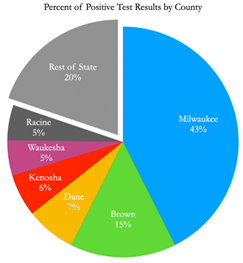
Cumulatively, the six counties with the most positive tests; Milwaukee (2,722), Brown (920), Dane (417), Kenosha (348), Waukesha (321) and Racine (308) account for 80% (5,036) of the state’s 6,289 positive test results.
Brown County and Milwaukee County account for two out of three positive test results (65.6%) in Wisconsin over the course of the last week.
Brown County alone during the last week accounted for 38% of the new positive test results. According to a report by the Associated Press on a briefing by Brown County Public Health more than 500 workers and their close contacts at meatpacking plants in and around Green Bay have tested positive for the coronavirus.
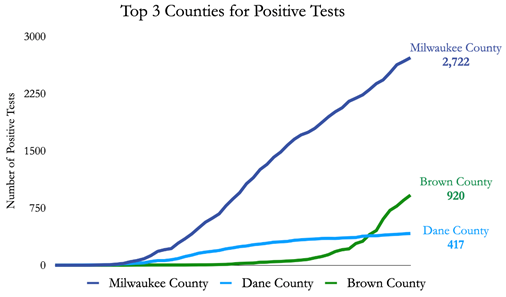
Updated Charts
Daily Numbers:
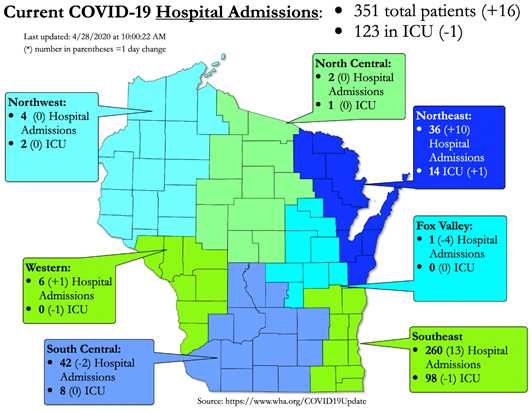
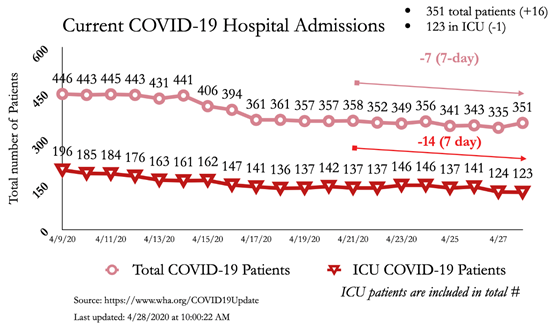
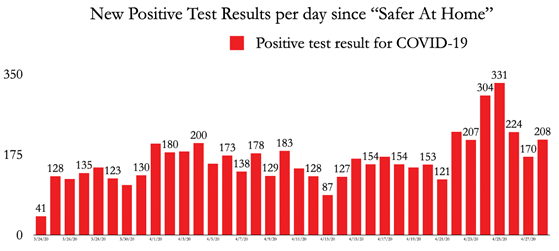
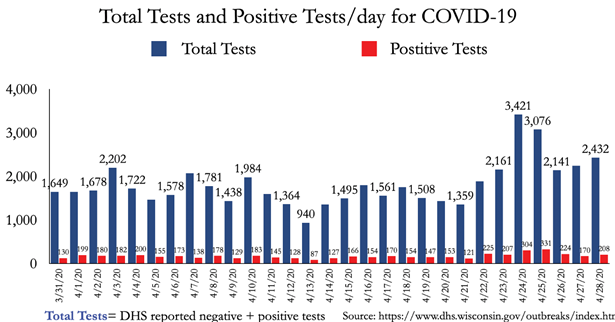

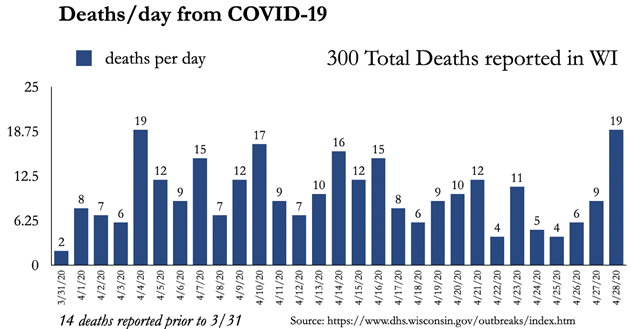
Cumulative Numbers:
